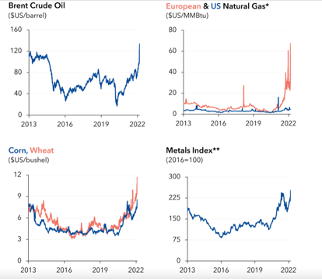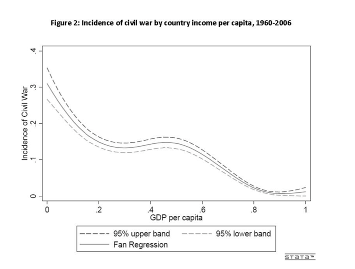Alejandro Posada-Tellez MSc, MA, BA (Hons). Alejandro is a DPhil (PhD) candidate in International Relations at the University of Oxford and Associate Lecturer in Strategic Studies at the University of Reading. He holds a BA in Politics and International Relations from SOAS, University of London; a MA in International Security from Sciences Po PSIA; and an MSc in International Relations from the London School of Economics. Alejandro’s doctoral research explores the intersection between the politics of victimhood and peacebuilding, and his main research interests are post-conflict transitions, reconciliation, and transitional justice.
Abstract
The ongoing conflicts in Ukraine and Sudan have led to catastrophic economic and humanitarian impacts, displacing millions of people and devastating the infrastructure of both countries. However, the literature on economics and peace gives a narrow account of the ways in which economic policy can assist with post-conflict reconstruction of these countries, limiting its insights to “one-size-fits-all” recommendations grounded on the benefit of hindsight. In response, this research paper explores the challenges and opportunities of post-conflict reconstruction in these two nations, with a focus on tailored economic policies to facilitate recovery. We find that in Ukraine, the Russian invasion has caused significant damage to energy and agriculture sectors, prompting recommendations for infrastructure rebuilding, adoption of renewable energy sources, and education initiatives to enhance human capital. Similarly, in Sudan, where power struggles have triggered a dire crisis, investing in healthcare infrastructure, supporting small and medium enterprises, attracting foreign investment, and safeguarding vulnerable groups are crucial to recovery. For both cases, we emphasise the importance of humanitarian aid, removal of travel restrictions, and protection for women and children. We also underscore the interconnectedness of economic policies, infrastructure, education, and humanitarian aid, highlighting the need for context-sensitive approaches guided by good governance and transparency to ensure successful post-conflict reconstruction. By offering specific policy recommendations, our research aims to contribute to recovery efforts and inform future economic policymaking in other conflict-ridden regions.
Introduction
The fog of war is currently crumbling the fabric of European and African societies. Russia’s invasion of Ukraine that ensued 18 months ago has displaced millions of Ukrainian families in the country and across the region, triggering the biggest and fastest-growing refugee crisis in Europe since the Second World War (UNHCR, 2023). A year later, more than eight million people have fled from Ukraine into neighbouring countries and an estimated six million Ukrainians are internally displaced, most of which are women and children, who account for approximately 90 percent of refugees (Ibid). Women face significant challenges and are at the greatest risk for sexual exploitation and abuse, human trafficking, and forced prostitution.
A similar crisis has been taking place in Sudan since April 2023. The current situation of this African country has been described by a former UN humanitarian coordinator as possessing ‘all the signature characteristics of genocide’ (Omer, 2023). There have been reports of extrajudicial killings, ethnic violence, and widespread hunger in the context of a growing humanitarian crisis. Between April and July, over 3.1 million people have been displaced, thousands are thought to have been killed, and even more wounded, with entire neighbourhoods and communities destroyed (Ibid).
These two ongoing crises have had catastrophic economic and humanitarian impacts both at a national and global level. In response to recent developments in these two countries, this research paper seeks to analyse and propose economic policies that can be used to facilitate the post-conflict reconstruction of Ukraine and Sudan once large-scale violence comes to an end. Specifically, we address the challenges and impact of inter- and intra-state wars on economic structures, focusing on the displacement of people whilst placing an emphasis on women and children at risk of exploitation and abuse.
The paper takes a forward-looking approach to these two conflicts, instead of the retrospective approach that dominates the literature in economics and peace studies. Indeed, there is a scarcity of information that tackles the potential economic strategies that war-torn nations can utilise in order to foster peace and security in the post-conflict period. As such, we seek to fill gaps in the existing literature by considering not only economic and financing methods for reconstruction, but also the intersectional economic challenges associated with security, displacement, and social development.
Our main argument is that economic policies must be tailored to the unique contextual circumstances of post-conflict settings. Using data about the economic impact of conflict in Ukraine and Sudan, we identify a series of economic policies that are likely to aid the post-war reconstruction of both countries, looking to match the particularities of each case. We find that in Ukraine, the Russian invasion has caused significant damage to energy and agriculture sectors, prompting recommendations for infrastructure rebuilding, adoption of renewable energy sources, and education initiatives to enhance human capital. Similarly, in Sudan, where power struggles have triggered a dire crisis, investing in healthcare infrastructure, supporting small and medium enterprises, attracting foreign investment, and safeguarding vulnerable groups are crucial to recovery.
Based on common lessons drawn from these two countries, we propose a number of general policies that are likely to enable economic stability in post-conflict contexts more generally. These recommendations highlight the connections between economic policies, infrastructure, education, and humanitarian aid.
The paper is structured as follows. First, we review the relevant literature on economic policy and peace, assessing some of the strengths and weaknesses of the scholarship’s engagement with the topic. Despite offering comprehensive insights, the literature tends to make one-size-fits-all recommendations that neglect contextual particularities and its recommendations are often done with the benefit of hindsight. We then explain how data was collected, and proceed to summarise some of the findings in relation to both cases. The “discussion” section interprets these findings, and comes up with specific economic policy recommendations for Ukraine and Sudan, whilst also addressing the general lessons that can be drawn from both cases. The conclusion summarises our key points and suggests avenues for further research.
Literature Review
The discourse surrounding economic policy as a vehicle for post-war reconstruction is extensive, offering insights into effective strategies and outcomes. Analysing the relationship between economic factors and conflict, research highlights the pivotal role of wealth and GDP per capita in influencing the likelihood of civil wars. Wealthier societies exhibit greater resilience against conflict due to their ability to safeguard assets, diminishing the appeal of violence for potential rebels.
Addressing the connection between poverty, conflict, and migration, scholars often underscore how scarcity-driven migrations can ignite conflicts over resources among identity groups (see, for example, Junne, 2005; Goldsmith and Brauer, 2010). This accentuates the need to tackle economic inequality and resource management during reconstruction (Collier et al., 2003). Delving into political manipulation of economies, the literature explores instances where leaders exploit economic policies for personal enrichment, thereby weakening state institutions and potentially encouraging violence (see, for example, Reno, 2000; Del Castillo, 2011; Humphreys, 2003).
The literature can be divided into two policy-based approaches: statistical analysis and case studies. For example, Homer-Dixon’s (1994) perspective highlights the link between poverty, violence, and resource-based conflicts. According to this author, scarcity-driven migrations can ignite conflicts among identity groups competing for resources, and the role of government policies in perpetuating or mitigating conflict is paramount. Reno’s (2000) analysis reveals instances where political leaders exploit economic policies to enrich themselves. Deliberate actions undermining economies weaken state institutions and can encourage violence by reducing both direct and opportunity costs. Governments may even organise violence with economic motivations, as observed in international conflicts and state-sponsored genocides.
Moreover, the relationship between trade interdependence and peace is examined through the lens of liberal and realist perspectives. This stream of scholarship demonstrates that states engaged in trade are less likely to fight each other, supporting the belief that trade can contribute to peaceful relations (see Keohane and Nye, 1973; Vieira, 2018). Yet, they also demonstrate that while interdependence can facilitate peaceful conflict resolution, it may also create tensions.
The existing literature on economic policies for post-war reconstruction has a number of strengths. First, their historical understanding of the economic determinants of conflict and peace tends to be complete and nuanced. In particular, the literature that explores case studies offers a comprehensive understanding of the impact of specific policies on a given country’s economic structures. Equally, their recommendations are well-informed and practical, and they are of great value to policymakers and governments working in post-conflict countries.
However, the existing literature on this topic also has certain weaknesses and gaps in information. Taking into account the four papers mentioned before, there is a narrow focus when analysing post-war reconstructions. The authors tend to focus on economic or financing methods but do not address or take into account other important aspects relevant to economic policy perspectives, like security, displacement, and social development. In addition, there is a lack of comparative analysis in the existing literature since the authors do not provide enough precise examples of economic policies that have been successful or otherwise across different post-conflict countries, making it difficult to evaluate the validity of their claims and reasoning. Most problematically, this leads a large portion of the literature to propose “one-size-fits-all” solutions that do not account sufficiently for contextual specificities.
In response to these limitations in the literature, we adopt a perspective that is yet to be explored by other literature of similar genres. We propose hypothetical economic policies that could foster the post-war reconstruction of the Ukrainian and Sudanese nations. The new approach that this research paper takes addresses the uncertain future of Ukraine and Sudan following the end of their respective violent conflicts. Currently, both wars are unfolding, and there is a scarcity of information presented about countries’ economic status and possibilities once the conflicts elapse. The aforementioned policies aspire to support the economic rejuvenation of nations that have suffered financial and humanitarian adversity whilst suggesting protocols to reach economic stability and flourishment. This paper will also provide contextual evidence on each case study, in order to ensure that the background for each case study is explained in depth and is comprehensive, unlike other research papers. Additionally, both countries are analysed using a prospective approach; not in hindsight or through a “one-size-fits-all” perspective, the two approaches that dominate the literature on economic policy and peacebuilding. This is a conscious choice since the purpose of this paper is to directly make recommendations that can be applied and are tailored to Ukraine and Sudan’s economic conditions in the post-conflict, but also to a greater range of post-war settings.
Data Collection
This paper employs a case study research approach to the Sudanese and Ukrainian cases. By assessing qualitative and quantitative data of the respective countries, we aim to provide a well-rounded picture of the similarities and differences of conflicts inter- and intra-nationally, as well as in different regions of the world. In particular, we take the findings for each case and tailor a number of recommendations for each conflict in order to maximise their potential effectiveness, whilst also speaking to the broader class of post-conflict countries.
Data on Ukraine and Sudan is sourced from publicly available statistical databases, economic reports, policy briefs, and research publications that strive for accurate information on humanitarian, political, and economic fluctuations. We consider that acquiring reliable and pertinent data is paramount in conducting research for a paper on war-torn settings. In this process, sourcing information from established databases, economic reports, policy briefs, and research studies becomes crucial. Renowned institutions like the World Bank and the International Monetary Fund (IMF) provide comprehensive insights into Ukraine and Sudan’s economic and developmental aspects. To achieve a comprehensive understanding, exploring academic databases such as official government publications can yield valuable information. Drawing data from a spectrum of reputable sources ensures accuracy and robustness. Cross-referencing multiple sources enhances the credibility of findings, enabling a well-rounded portrayal of Ukraine and Sudan’s current status and historical background.
In particular, the method we follow to gather and analyse data is document reviews and text analysis. The aforementioned case study approach relies on examining existing conditions and outcomes, as policies tend to be very specific to each circumstance. The following arguments source information from the websites of international organisations (United Nations, Organization for Economic Co-operation and Development, International Labour Organisation, European Union, etc.) and non-governmental organisations (Overseas Development Institute, Human Rights Watch, etc.). We use their material, such as Common Operational Datasets and Humanitarian response plans, in order to provide a more accurate and nuanced profile of each country. Non-profit and international organisations are more likely to provide unbiased data since they tend to be partial players and aim to inform people about policy-making. Additionally, the multiple governments within each committee can hold each other accountable, further preventing pressure from one party.
Findings
Ukraine: A national crisis turned global
The war in Ukraine began on February 24, 2022, following the Russian Federation’s invasion of the country. As a result of heavy shelling and fighting, an estimated 5.1 million people have been driven from their homes and are internally displaced, and more than 6.2 million people have crossed into neighbouring countries in the region, including Poland, Hungary, Moldova, or other countries globally (UNHCR, 2023a). The war in Ukraine has caused missile and rocket attacks that have resulted in widespread death, destruction of homes and businesses, and severe damage to energy infrastructures across the country. (Ibid.) This energy crisis is disrupting access to water, electricity, heating, healthcare, education, and social protection (Ferriani & Gazzani, 2023). Older people, people with disabilities, women, and children are particularly vulnerable in this situation. It is estimated that 17.6 million people in Ukraine will need humanitarian assistance in 2023 (UNHCR, 2023a).
Ukraine’s economy shrank by more than 30% in 2022 after Russia’s brutal invasion destroyed infrastructure, hurt businesses and disrupted daily life (Horowitz, 2023). According to the country’s economy ministry, ‘During 2022, Ukraine’s economy suffered the largest losses and damage in the history of its independence’ (Ibid). The projected 30.4% contraction in gross domestic product is much better than experts feared shortly after Russia’s invasion in February 2022, given that at the time, many projected that Ukraine’s economic output would plunge by between 40% and 50% (Ibid). The cost of reconstruction and recovery in Ukraine was put at roughly $349 billion in a September assessment from the World Bank, the European Commission and Ukraine’s government (Ibid). Ongoing fighting will have raised the price tag since then. Tens of billions of dollars in foreign aid from the West has also played a crucial role, allowing the government to continue to provide services (Ibid).
Disruptions and attacks on export hubs along the Danube River are posing risks to grain exports, potentially leading to price increases and impacting trade not only in Ukraine but also in the rest of Europe (Horton, 2023). The absence of a grain transport deal with Russia has effectively blocked Ukraine’s Black Sea ports, forcing the country to transport grain through the Danube River at higher costs (Ibid.). Ongoing war has disrupted Ukraine’s grain exports as Russia targets key alternative export routes along the Danube River (Ibid.). With Black Sea ports blocked, Ukraine heavily relies on Danube River ports to export grain to neighbouring countries like Romania (Ibid.). Ukrainian ports along the Danube have been attacked, further hindering grain exports and potentially causing wheat prices to increase (Ferriani 7 Gazzani, 2023; Horton, 2023).
Ukraine’s grain exports are crucial not just for Ukraine but also for the global economy, as Ukraine and Russia together account for nearly a quarter of total global grain exports (Arce et al., 2023). The disruption in grain exports affects not only Ukraine but also countries heavily reliant on these exports, such as Egypt and Turkey (Ibid.). In addition, international prices for energy, grains, and metal have increased since Russia’s invasion, affecting the entirety of global trade (Kammer et al., 2022). Such tendencies are demonstrated in Figure 1 below.

Figure 1: Kammer et al., 2022
Sudan: An economic and public health emergency
Sudan’s current war broke out on April 15, 2023 from a power struggle between General Abdel Fattah Al Burhan, the president of Sudan, and General Mohamed Hamdan Dagalo, the vice-president. They each led Sudanese Armed Forces (SAF) and Rapid Support Forces (RSF) respectively into a chaotic battle centred around the capital of Khartoum.
As a result, 3.2 million people have been internally displaced and even more have become refugees at around 4 million. (UNHCR, 2023b) Since more and more flood into neighbouring countries such as Chad, Egypt, Ethiopia and South Sudan, limited resources deplete in already conflict-prone areas, increasing tension. John Mukum Mbaku for The Conversation dubs the risk of spreading conflict from Sudan to those nearby as “a ripple effect” (Mbaku, 2023).
Mass movement has brought greater risk upon the displaced due to a lack of accessible hygiene, protection, shelter and the ever-present risk of stray debris (ICRC, 2023). While these threats increase, first aid decreases considering only 20% of hospitals in Khartoum are still in operation while others are looted and driven out of staff (Ibid).
With rainy seasons approaching, the non-governmental organisation Assessment Capacities Project (ACAPS) published a report on Sudan’s increasing flooding and rain unpredictability due to climate change and its impacts on civilians, especially under turbulent conditions. The report claims that the rainy seasons that Sudan’s geography brings may amount to an increase in vector and water borne diseases such as malaria, polio dengue, and chikungunya (ACAPS, 2023). The lack of access people have to humanitarian aid is heightened by the current conflict’s dangerous conditions. Coupled with the weather, geography and lack of healthcare, the instability in many people’s lives is likely to persist (Ibid).
In terms of Sudan’s economy, its devastation rose due to the bankruptcy of local businesses, the escalation of inflation and the fall of the local currency, the lack of foreign investment, and the increase of debt (Abdelaziz et al., 2023). Sudan’s actual GDP after the break out of the civil war settles down at -0.95% growth, meaning Sudan is below the average GDP which is expected to settle down between 2%-3% growth (Ibid). This negative value indicates the economy of Sudan is declining year by year by 0.95%.
It has been proven that the lower the GDP of a country the more likely it is for it to break out in a civil war. As Miguel and Satyanath (2011) argue in their article about economics and civil war, the correlation between civil conflicts and economic crises and inequality is clear and evident. As Figure 2 suggests, there is an evident negative relationship between the incidence rates of civil wars and the GDP per capita, meaning that as GDP increases, the incidence rates of civil war will decrease. In the case of Sudan, initially one of the reasons why the civil war broke out was the economic inequalities present in Sudanese society (ACAPS, 2023). This correlation also indicates that Sudan’s civil war is likely to continue deepening as its GDP continues to plunge, demonstrating a clear relationship between peace and economics.

Figure 2: Miguel and Satyanath, 2011: 229
Moreover, Sudan’s conflict has consequences not only felt within its borders but through the rest of Africa too. Port Sudan, which makes up 90% of Sudan’s international trade, is located next to the Red Sea (Mbaku, 2023). It additionally acts as a port for countries within Africa that do not have direct access to the ocean. The ongoing conflict could intercept or prevent needed trade of necessities and have detrimental effects on economies susceptible to external shocks and are reliant on landlocked African countries as a food source (Ibid). Furthermore, the Suez Canal is just north of the Red Sea and makes up 12% of global trade. If the conflict threatens the journey of hundreds of shipping vessels; short-term inflation and decreased global interconnectedness is at risk (New Zealand Foreign Affairs and Trade, 2021).
Discussion
The above findings suggest that the economies of Ukraine and Sudan have both been significantly weakened by their respective inter-state and intra-state wars. Hence, to support both countries’ post-war reconstruction, it is essential that governments ensure greater investment in infrastructure, education, and humanitarian aid. Moreover, fiscal and monetary policies should be oriented towards economic growth, sustainability, and the reactivation of economic relations. This section discusses these recommendations, one by one, based on our findings.
Infrastructure
First, a good infrastructure, such as transport and communication systems, electricity, buildings, and power systems, is a necessary condition for economic productivity. As such, investment in rebuilding crucial infrastructure, including roads, bridges, railways, and energy facilities, is essential for stimulating economic growth and job creation. Ensuring even distribution of reconstruction efforts across the nation promotes balanced growth. Public-private collaboration can play a pivotal role in executing such projects.
Together, the Ukraine-Russia and Sudanese wars have led to the internal displacement of approximately nine million people. Our findings demonstrate that many have lost their homes and villages due to the destruction caused by these conflicts, resulting in two significant refugee crises in Africa and Europe. In the aftermath of these conflicts and displacement, infrastructure stands as a fundamental requirement for future economic revival and the restoration of normalcy in people’s lives. Good governance is key to achieve this objective, which makes it important to implement anti-corruption and transparent governance policies, looking to ensure that resources are channelled efficiently into the reconstruction of both nations’ infrastructures.
In the case of Ukraine, the lower capacity of Ukrainian agricultural workers to grow and export grain as a result of the war means the government should direct its fiscal policy into rebuilding agricultural infrastructure. The Ukrainian government could invest in modern farming techniques and invest in rebuilding roads connecting rural areas with urban areas and port cities, which would be a crucial first step to enhance local and international food security and promote economic development in rural areas.
Additionally, following our finding that the war in Ukraine has resulted in extensive damage to various infrastructures, including energy-related facilities, we consider that the government should accelerate the shift towards renewable energy sources. It is important that Ukraine reduces its reliance on fossil fuels and enhances its energy security, which we believe can be achieved through increased investment and policy favouring renewable infrastructure like solar and wind energies.
In Sudan, our findings point to an urgent public health emergency. We therefore consider that the government should use fiscal policy to upgrade and reconstruct healthcare facilities and expand access to quality healthcare services. This may begin to improve public health outcomes and workforce productivity. Given that Sudan has less resources available to spend on infrastructure than Ukraine, the Sudanese government should actively seek aid from international organisations, donor countries, and developmental banks to fund post-conflict reconstruction efforts. This external funding can play a pivotal role in rebuilding infrastructure and promoting economic recovery.
These points address the importance of investing in infrastructure, particularly in the context of economic growth, agricultural development, and post-conflict recovery following the Ukraine-Russia and Sudanese wars.
Education
Focusing on education and skills development is crucial for rebuilding the workforce in both Ukraine and Sudan, which our findings have shown have been affected heavily in both countries. Initiatives like training programs for displaced workers and scholarships to promote higher education can play a key role in enhancing human capital.
Additionally, efforts to restore cultural heritage, such as art and historical buildings, can attract tourism. Cultural preservation not only boosts tourism but also contributes to national identity and pride.
Education has a multifaceted impact on economic growth. Accessible education expands the mobility and skills of the workforce, leading to increased economic potential. This is especially relevant in Ukraine, given that the level of socio-economic development was advanced before the war, which justifies the need for greater investment in education. This should in principle motivate many refugees who left during the war to return, because as people reach higher education and acquire skills, they can pursue higher-income opportunities and become more productive.
Moreover, education can serve as a catalyst for social reintegration. In both Sudan and Ukraine, where a large number of refugees have been displaced, education can be a driving force for people to return, thereby positively impacting both the population and the economic landscape.
In Sudan particularly, education programs should extend beyond economic benefits. They should address important aspects of daily life, such as sexual education, hygiene, and sanitation, contributing to overall societal well-being and economic development.
A strong emphasis on learning abilities can catalyse business and economic development. A nation’s economic progress is fundamentally linked to the development of its people. Business growth hinges on individual capacities, and fostering good learning abilities is integral to building a strong economy.
For a country to develop comprehensively, the development of its citizens is paramount. Establishing or reconstructing quality educational facilities, including schools and universities, is crucial for nurturing a skilled workforce and supporting economic growth for both Ukraine and Sudan.
Humanitarian aid
Our findings also suggest that in the aftermath of war in Ukraine and Sudan, humanitarian aid is a critical aspect to address because a substantial amount of individuals suffer from displacement, medical injuries, and mental and emotional fluctuations. It is therefore crucial to remove travel restrictions so that humanitarian aid can reach those in need quickly, especially in Sudan, where the geographical and demographic conditions are especially challenging. This involves granting aid workers safe and efficient passage, both by road and air. Streamlining visa processes and easing customs restrictions for essential supplies can ensure assistance reaches affected populations.
Special attention should be given to safeguarding women and children from war-related crimes and abuse. This is especially true for Sudan, where the track record for women’s protection is weak. Policies must prioritise their protection and provide necessary support to ensure their well-being in the post-war environment.
These actions are essential for providing timely and effective humanitarian assistance to Ukraine and Sudan as they recover from the impacts of conflict. They emphasise the importance of enabling aid workers’ access and enhancing the safety and protection of the most vulnerable populations.
Economic growth
Second, ensuring a stable and sustainable economic growth is imperative for both countries’ financial stability. Given that Ukraine and Sudan have a significant refugee problem, the key to achieve economic growth is to support the return and productivity of their respective workforces, which requires incentives. By supporting small and medium enterprises, attracting foreign investment, and recognizing the connection between peace and economic growth, the Ukrainian and Sudanese governments can support the post-conflict economic revitalisation of their countries.
Indeed, to encourage entrepreneurship and economic progress, both countries should consider providing low-interest loans and grants to small and medium enterprises. This approach can stimulate job creation, innovation, and overall economic growth. Such measures may also align with expansionary monetary policies. It is crucial that these forms of financing are sustainable, which would result in more affordable and durable energy sources for citizens, whilst positively contributing to environmentally friendly incentives and projects.
Furthermore, by offering improved investor protection and tax incentives, Ukraine and Sudan can attract foreign investors. These measures create an investor-friendly environment that encourages foreign companies to bring technology, capital, and expertise to these nations’ economies. Governments in both Ukraine and Sudan should also implement policies that incentivize small businesses to take calculated risks. Stable environments are conducive to fostering entrepreneurship, which in turn contributes to economic growth.
At the core of a sustainable economic growth, much like with other recommendations, is good governance. Economic policies that pursue the aspect of governance are weighty in sustaining government accountability, and that all economic policies that accomplish the categories discussed above are genuinely being implemented. Additionally, transparency among the government is notable in the prevention of future conflicts of similar manifestation. This final point will be specifically explored in the conclusion section of this research paper.
Conclusion
The ongoing conflicts in Ukraine and Sudan have brought about profound humanitarian and economic crises, displacing millions of people, devastating infrastructure, and undermining the stability of these nations. In this research paper, we sought to examine the unique challenges and opportunities presented by each of these conflicts, focusing on economic policies that can facilitate post-conflict reconstruction.
In Ukraine, the war with Russia has left a trail of destruction, displacing millions and causing significant damage to infrastructure. The economic repercussions have been substantial, with GDP contracting and vital sectors like energy and agriculture being severely affected. The path to reconstruction requires comprehensive fiscal policy action to ensure investment in infrastructure, focusing on rebuilding energy facilities, roads, and agricultural systems. A shift toward renewable energy sources can enhance energy security and contribute to sustainable economic growth. Furthermore, educational initiatives should be prioritised to foster skill development and human capital, promoting workforce reintegration and economic reactivation.
Like in Ukraine, Sudan’s conflict, marked by power struggles and violence, has also triggered a dire humanitarian and economic crisis. Millions have been displaced, healthcare systems have crumbled, and economic indicators have plummeted. The revitalisation of Sudan’s economy requires substantial investment in healthcare infrastructure, addressing public health emergencies and facilitating workforce recovery. Additionally, efforts to alleviate the impact of conflict-induced poverty and stimulate economic growth should include support for small and medium enterprises, foreign investment attraction, and the implementation of policies that protect vulnerable groups, particularly women and children.
In both cases, fiscal and monetary policies should look to foster economic growth, sustainability, and the reactivation of healthy economic relations. As a first step, humanitarian aid is crucial to advance the well-being and recovery of affected populations. Removing travel restrictions, providing safe access for aid workers, and enacting policies to safeguard women and children from abuse are also critical components of the reconstruction process. These economic policies aim to support citizens financially and socially in a manner that will make their reintegration back into their home countries as efficient and optimal as possible.
As the paper has demonstrated, the interconnectedness of economic policies, infrastructure development, education, and humanitarian aid is vital for post-conflict recovery. To effectively navigate the complexities of reconstruction, we argue that approaches and solutions should be tailored to the unique contextual circumstances of each conflict setting. Good governance and transparency are pivotal for ensuring the proper implementation of policies and fostering a conducive environment for economic stability and growth.
By offering specific policy recommendations informed by the unique circumstances of these nations, we hope to contribute to their paths of recovery and provide insights for other post-conflict settings. Further research should also seek to adopt our forward-looking perspective, driven by data, context-sensitive policies, and international cooperation, in a way that can inform economic policymaking effectively to bring about economic stability, social development, and lasting peace in these war-torn regions and beyond.
Bibliography
Abdelaziz, Khalid, El Safty, Sarah, and Eltahir, Nafisa (2023). Sudan conflict deals new blow to stagnant economy. Reuters. https://www.reuters.com/world/africa/sudan-conflict-deals-new-blow-stagnant-economy-2023-05-04/
ACAPS (2023). Sudan: Anticipated impacts of the 2023 rainy season. ACAPS. https://www.acaps.org/fileadmin/Data_Product/Main_media/20230621_ACAPS_Thematic_report_Sudan_anticipated_impacts_of_the_2023_rainy_season.pdf
Arce, Óscar et al. (2023) “One Year since Russia’s Invasion of Ukraine – the Effects on Euro Area Inflation.” European Central Bank. www.ecb.europa.eu/press/blog/date/2023/html/ecb.blog20230224~3b75362af3.en.html
Collier, Paul et al. (2003) “Breaking the Conflict Trap: Civil War and Development Policy.” World Bank Report.
Del Castillo, Graciana (2011) “The Economics of Peace: Five Rules for Effective Reconstruction.” US Institute of Peace Report.
Gartzke, Eric, Li, Quan, and Boehmer, Charles (2001) “Investing in the peace: Economic interdependence and international conflict.” International Organization, vol. 55, no. 2, pp. 391-438.
Homer-Dixon, Thomas F. (1994). “Environmental Scarcities and Violent Conflict: Evidence from Cases.” International Security, vol. 19, no. 1, pp. 5–40.
Humphreys, Macartan (2003) “Economics and Violent Conflict.” Harvard Program on Conflict & Development. https://hhi.harvard.edu/sites/hwpi.harvard.edu/files/humanitarianinitiative/files/economics_and_conflict.pdf?m=1615499917
Ferriani, Fabrizio, and Gazzani, Andrea (2023).. The Ukraine invasion and the energy crisis: Comparative advantages in equity valuations. VoxEU. https://cepr.org/voxeu/columns/ukraine-invasion-and-energy-crisis-comparative-advantages-equity-valuations
ICRC (2023). Sudan: Vital surgical supplies reaching hospitals in Khartoum. International Committee of the Red Cross. https://www.icrc.org/en/document/icrc-sudan-vital-surgical-supplies-reaching-hospitals-khartoum
Junne, Gerd (2005) “Postconflict Development: Meeting New Challenges.” New York: Lynne Rienner Publishers.
Keohane, Robert O., and Nye, Joseph S. (1973) “Power and interdependence.” Survival, vol. 15, no. 4, pp. 158-165.
Kammer, Alfred et al. (2022). How War in Ukraine Is Reverberating Across World’s Regions. International Monetary Fund. https://www.imf.org/en/Blogs/Articles/2022/03/15/blog-how-war-in-ukraine-is-reverberating-across-worlds-regions-031522
Vieira, Patricia (2018) “Trading our way out of war: Perpetual peace without politics.” Revista Crítica de Ciências Sociais, no. 116, pp. 5-22.
Goldsmith, Benjamin E., and Brauer, Jurgen (2010) “Economics of War and Peace.” London: Emerald.
Miguel, Edward, and Satyanath, Shanker (2011) “Re-examining Economic Shocks and Civil Conflict.” American Economic Journal: Applied Economics, vol. 3, no. 4, pp. 228-232.
New Zealand Foreign Affairs and Trade (2021). The Importance of the Suez Canal to Global Trade. Government of New Zealand. https://www.mfat.govt.nz/en/trade/mfat-market-reports/the-importance-of-the-suez-canal-to-global-trade-18-april-2021/#:~:text=The%20193km%20Suez%20canal%20was,worth%20of%20goods%20per%20annum
Omer, Nimo (2023). Monday Briefing: Thousands Killed, Millions Displaced – the Conflict in Sudan, Three Months In. The Guardian. www.theguardian.com/world/2023/jul/17/sudan-conflict-three-months-on
Reno, William (2000). “Clandestine Economies, Violence and States in Africa.” Journal of International Affairs, vol. 53, no. 2, pp. 433–59.
UNHCR (2023a). Ukraine Refugee Crisis: Aid, Statistics and News. UNHCR. www.unrefugees.org/emergencies/ukraine/
UNHCR (2023b). Health conditions worsen as displacement from Sudan conflict exceeds 4 million. UNHCR. https://www.unhcr.org/news/briefing-notes/health-conditions-worsen-displacement-sudan-conflict-exceeds-4-million#:~:text=Within%20Sudan%2C%20over%203.2%20million,and%20other%20live%2Dsaving%20aid
Horowitz, Julia (2023). Ukraine’s Economy Shrank by More than 30% in 2022. CNN. https://www.edition.cnn.com/2023/01/05/business/ukraine-economy/index.html
Horton, Jake (2023). Russia’s New Tactic for Cutting off Ukraine’s Grain. BBC News. www.bbc.com/news/world-europe-66328810
Mbaku, John Mukum (2023). Sudan’s conflict will have a ripple effect in an unstable region – and across the world. The Conversation. https://theconversation.com/sudans-conflict-will-have-a-ripple-effect-in-an-unstable-region-and-across-the-world-204858




